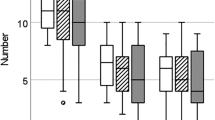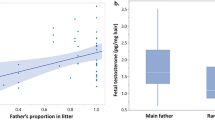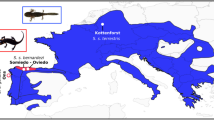Abstract
Females commonly mate with more than one male1, and polyandry has been shown to increase reproductive success in many species2,3,4. Insemination by multiple males shifts the arena for sexual selection from the external environment to the female reproductive tract, where sperm competition or female choice of sperm could bias fertilization against sperm from genetically inferior5 or genetically incompatible males6,7. Evidence that polyandry can be a strategy for avoiding incompatibility comes from studies showing that inbreeding cost is reduced in some egg-laying species by postcopulatory mechanisms that favour fertilization by sperm from unrelated males8,9,10. In viviparous (live-bearing) species, inbreeding not only reduces offspring genetic quality but might also disrupt feto-maternal interactions that are crucial for normal embryonic development11,12,13. Here we show that polyandry in viviparous pseudoscorpions reduces inbreeding cost not through paternity-biasing mechanisms favouring outbred offspring, but rather because outbred embryos exert a rescuing effect on inbred half-siblings in mixed-paternity broods. The benefits of polyandry may thus be more complex for live-bearing females than for females that lay eggs.
This is a preview of subscription content, access via your institution
Access options
Subscribe to this journal
Receive 51 print issues and online access
$199.00 per year
only $3.90 per issue
Buy this article
- Purchase on Springer Link
- Instant access to full article PDF
Prices may be subject to local taxes which are calculated during checkout


Similar content being viewed by others
References
Jennions, M. D. & Petrie, M. Why do females mate multiply? A review of the genetic benefits. Biol. Rev. Camb. Phil. Soc. 75, 21–64 (2000)
Hasselquist, D., Bensch, S. & von Schantz, T. Correlation between male song repertoire, extra-pair paternity and offspring survival in the great reed warbler. Nature 381, 229–232 (1996)
Tregenza, T. & Wedell, N. Polyandrous females avoid the costs of inbreeding. Nature 415, 71–73 (2002)
Stockley, P. Female multiple mating behaviour, early reproductive failure and litter size variation in mammals. Proc. R. Soc. Lond. B 270, 271–278 (2003)
Birkhead, T. R., Møller, A. P. & Sutherland, W. J. Why do females make it so difficult for males to fertilize their eggs? J. Theor. Biol. 161, 51–60 (1993)
Zeh, J. A. & Zeh, D. W. Reproductive mode and the genetic benefits of polyandry. Anim. Behav. 61, 1051–1063 (2001)
Tregenza, T. & Wedell, N. Genetic compatibility, mate choice and patterns of parentage: invited review. Mol. Ecol. 9, 1013–1027 (2000)
Olsson, M., Shine, R., Madsen, T., Gullberg, A. & Tegelström, H. Sperm selection by females. Nature 383, 585 (1996)
Foerster, K., Delhey, K., Johnsen, A., Lifjeld, J. T. & Kempenaers, B. Females increase offspring heterozygosity and fitness through extra-pair matings. Nature 425, 714–717 (2003)
Bretman, A., Wedell, N. & Tregenza, T. Molecular evidence of post-copulatory inbreeding avoidance in the field cricket Gryllus bimaculatus. Proc. R. Soc. Lond. B 271, 159–164 (2004)
Ober, C. et al. Variation in the HLA-G promoter region influences miscarriage rates. Am. J. Human Genet. 72, 1425–1435 (2003)
Choudhury, S. R. & Knapp, L. A. Human reproductive failure II: immunogenetic and interacting factors. Human Reprod. Update 7, 135–160 (2001)
Davies, C. J. et al. Major histocompatibility antigen expression on the bovine placenta: its relationship to abnormal pregnancies and retained placenta. Anim. Reprod. Sci. 82–83, 267–280 (2004)
Keller, L. F. & Waller, D. M. Inbreeding effects in wild populations. Trends Ecol. Evol. 17, 230–241 (2002)
Hill, J. A. in Immunology of Human Reproduction (eds Kurpisz, M. & Fernandez, N.) 401–424 (Bios Scientific, Oxford, UK, 1995)
Weygoldt, P. The Biology of Pseudoscorpions (Harvard Univ. Press, Cambridge, MA, 1969)
Newcomer, S. D., Zeh, J. A. & Zeh, D. W. Genetic benefits enhance the reproductive success of polyandrous females. Proc. Natl Acad. Sci. USA 96, 10236–10241 (1999)
Zeh, D. W., Zeh, J. A. & Bermingham, E. Polyandrous, sperm-storing females: carriers of male genotypes through episodes of adverse selection. Proc. R. Soc. Lond. B 264, 119–125 (1997)
Zeh, D. W., Zeh, J. A. & May, C. A. Charomid cloning vectors meet the pedipalpal chelae: single-locus minisatellite DNA probes for paternity assignment in the harlequin beetle-riding pseudoscorpion. Mol. Ecol. 3, 517–522 (1994)
Rosenthal, R. & Rosnow, R. L. Contrast Analysis. Focused Comparisons in the Analysis of Variance (Cambridge Univ. Press, Cambridge, UK, 1985)
Simmons, L. W. The evolution of polyandry: an examination of the genetic incompatibility and good-sperm hypotheses. J. Evol. Biol. 14, 585–594 (2001)
Hoffmann, J. A. The immune response of Drosophila. Nature 426, 33–38 (2003)
Caucheteux, S. M., Kanellopoulos-Langevin, C. & Ojcius, D. M. At the innate frontiers between mother and fetus: linking abortion with complement activation. Immunity 18, 169–172 (2003)
Haig, D. Genetic conflicts in human pregnancy. Q. Rev. Biol. 68, 495–532 (1993)
Jennions, M. D., Hunt, J., Graham, R. & Brooks, R. No evidence for inbreeding avoidance through postcopulatory mechanisms in the black field cricket, Teleogryllus commodus. Evolution 58, 2472–2477 (2004)
SAS Institute, The SAS System for Windows, Release 8.02 (SAS Institute, Cary, 2001)
Schluter, D. & Nychka, D. Exploring fitness surfaces. Am. Nat. 143, 597–616 (1994)
Acknowledgements
We thank M. Bonilla and S. Trimmer for assistance; K. Panter for discussion; the Smithsonian Tropical Research Institute for logistical support; and La Autoridad Nacional del Ambiente for permission to collect in Panama. This research was supported by grants from the US National Science Foundation and the National Geographic Society. Author Contributions J.A.Z. designed the study, carried out the mating and rearing experiments, and took the primary role in writing the paper. D.W.Z. performed the molecular and statistical analyses.
Author information
Authors and Affiliations
Corresponding author
Ethics declarations
Competing interests
Reprints and permissions information is available at npg.nature.com/reprintsandpermissions. The authors declare no competing financial interests.
Supplementary information
Supplementary Methods
This file contains the full, detailed version of the Methods. (DOC 46 kb)
Rights and permissions
About this article
Cite this article
Zeh, J., Zeh, D. Outbred embryos rescue inbred half-siblings in mixed-paternity broods of live-bearing females. Nature 439, 201–203 (2006). https://doi.org/10.1038/nature04260
Received:
Accepted:
Issue Date:
DOI: https://doi.org/10.1038/nature04260
This article is cited by
-
Meta-analytic evidence that animals rarely avoid inbreeding
Nature Ecology & Evolution (2021)
-
Reproductive Success and Body Size in the Cricket Gryllus firmus
Journal of Insect Behavior (2014)
-
Wild yellow dung fly females may not select sperm based on dung pat microclimate but could nevertheless benefit from polyandry
Evolutionary Ecology (2012)
-
Sources of phenotypic variance in egg and larval traits in a marine invertebrate
Evolutionary Ecology (2010)
-
Multiple paternity and offspring quality in tree swallows
Behavioral Ecology and Sociobiology (2009)
Comments
By submitting a comment you agree to abide by our Terms and Community Guidelines. If you find something abusive or that does not comply with our terms or guidelines please flag it as inappropriate.



